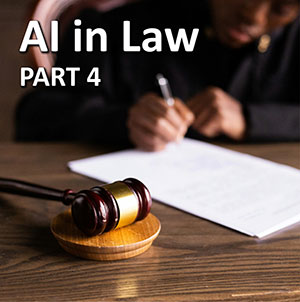 Artificial Intelligence is quickly becoming part of everyday legal work, from document drafting to cybersecurity. But for lawyers, one question always comes first: Is it ethical? Let’s walk through what the ABA and bar associations actually expect—and how you can explore AI confidently without risking compliance, client trust, or your reputation.
Artificial Intelligence is quickly becoming part of everyday legal work, from document drafting to cybersecurity. But for lawyers, one question always comes first: Is it ethical? Let’s walk through what the ABA and bar associations actually expect—and how you can explore AI confidently without risking compliance, client trust, or your reputation.
Let’s Start with the Big Picture
AI is just another tool—like email, e-filing, or legal research software.
And just like any tool, it’s how you use it that determines whether it’s ethical.
Bar associations and regulators aren’t against AI.
They simply expect lawyers to apply the same professional standards we always have: competence, confidentiality, and client communication.
The good news?
You already know how to handle those—AI just adds a new context.
1️ Competence: Know What You’re Using
Under ABA Model Rule 1.1, lawyers must provide competent representation.
That includes keeping up with “the benefits and risks associated with relevant technology.”
In plain English:
You don’t have to build AI—but you do have to understand enough to use it wisely.
That means:
- Knowing whether an AI tool is cloud-based (and where that data is stored).
- Understanding what happens to client information you input.
- Realizing that AI output can contain errors or bias—and that you’re still responsible for verifying it.
Think of it as “tech due diligence.” You don’t need to be a coder; you just need to ask good questions.
2️ Confidentiality: Protecting Client Information
This one’s critical. ABA Model Rule 1.6(c) requires lawyers to make “reasonable efforts” to prevent unauthorized disclosure of client data.
So before you use any AI tool, ask:
- Does this system store what I type?
- Who can see that data?
- Can I delete it?
- Is it encrypted in transit and at rest?
Never paste confidential client information into a public AI tool (like the free version of ChatGPT or Google Bard).
Instead, use tools that:
✅ Offer private, enterprise, or “zero retention” modes.
✅ Have signed data protection agreements.
✅ Comply with your cyber-insurance and bar requirements.
Remember—protecting your client’s privacy isn’t optional. It’s the foundation of your license.
3️ Oversight: You Can Delegate, but Not Abdicate
AI can draft a document, summarize a case, or analyze data—but you remain responsible for the results.
The ABA and several state bar opinions make this crystal clear:
Lawyers can use AI assistance, but they must verify the accuracy, appropriateness, and originality of the work before relying on it.
That means:
- Review every AI-generated draft before sending it to a client or filing it.
- Make sure citations are real and accurate.
- Ensure tone, confidentiality, and professional judgment remain intact.
In short: treat AI like a bright intern who sometimes works too fast.
4️ Transparency: Tell Clients When It Matters
You don’t have to announce every use of AI—but transparency builds trust.
If you’re using AI to assist with tasks that touch client work (especially drafting or billing), consider including a short disclosure in your engagement letter.
Something simple like:
“Our firm may use secure AI-assisted tools to improve efficiency and quality. These tools are used under attorney supervision and in compliance with all professional and confidentiality rules.”
It’s honest, clear, and professional—and most clients will appreciate that you’re forward-thinking and careful.
5 Avoiding Bias and Misuse
AI systems learn from data, and data can carry bias.
So, if you rely on AI for research or analysis, always double-check for fairness, accuracy, and tone.
Ask yourself:
- Could this wording sound insensitive or inaccurate?
- Did the AI assume facts not in evidence?
- Is this advice consistent with legal precedent and ethics rules?
Good lawyers already think this way—it’s just a new arena for the same careful habits.
Bonus Tip: Align AI Use with Cyber-Insurance
Many firms are surprised to learn their cyber-insurance carriers now ask about AI usage during renewal.
They want to see documented policies for data protection, employee training, and vendor management.
So if you’re exploring AI, make it official:
- Add it to your Written Information Security Program (WISP).
- Note which AI tools are approved and what data they may handle.
- Review those tools quarterly, just like any other vendor.
That’s not red tape—it’s smart risk management.
The Ethical Bottom Line
✅ AI is allowed in law practice.
✅ You must remain competent and cautious.
✅ Client data is never to be exposed.
✅ Final responsibility always stays with the lawyer.
Use those four principles, and you’ll be ahead of 90% of firms still trying to sort this out.
You don’t need to be the first to adopt every tool—just the one who does it right.
Call to Action: Build Confidence, Not Chaos
If you’d like help setting clear, compliant boundaries for AI use at your firm, our team can guide you.
We speak both languages—legal and tech—and we’ll help you design an approach that meets ABA and insurance standards without slowing your workflow.
Let’s make your firm AI-ready—with peace of mind built in.
Next: The Future of AI in Law — What’s Coming Next (and How to Prepare Now)
Previous: Practical Ways AI Can Support a Law Firm—Right Now (Without Risking Compliance)


